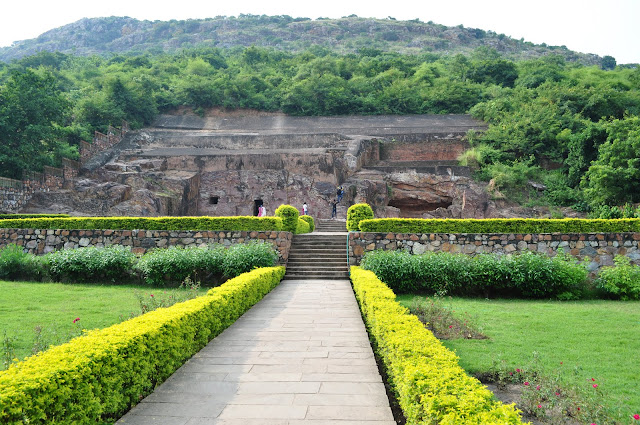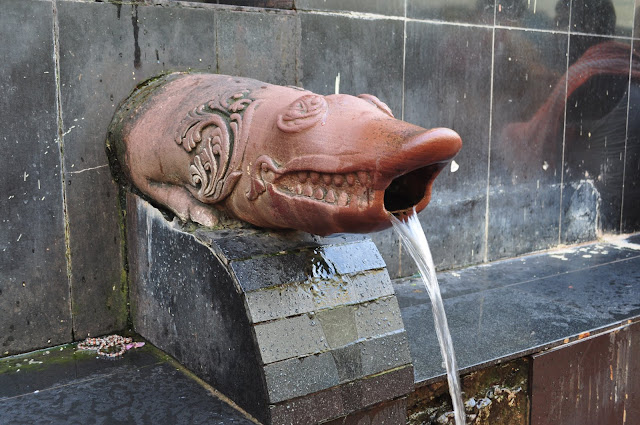Sone bhandar Caves is the ultimate mysterious challenge and more like an Indiana Jones moment in Rajgir. This simple looking cave could very well be your elite luxurious retirement bonanza. If only you could decipher the inscription on the caves. Legend has it that incredible amount of gold and precious stones are hidden here and cracking this code would be the key to this treasure. When Britishers failed the intelligence test of our forefathers they resorted to brute force by firing canon balls in the hope of getting their hands on the booty. Needless to say their choice was not a smart one.
En-route to sone bhandar is Maniyar Matt dedicated to serpent Goddess. This structure resembles a well and has some interesting images such as Ganesh with snakes wrapped around, a six armed dancing Shiva and a four armed Vishnu. Sadly though most of these images have been ruined.
Bimbisar Jail or barely the remains of it today. If not for the board by Bihar Tourism, this place left us perplexed as to what should we see. It just looks like any other barren land. However, we were told that there was an underground prison where King Bimbisar was imprisoned by his son Ajatashatru. The site for the prison was chosen by the King himself, over looking the Griddhakuta hill. This hill is believed to have been used by Buddha to preach and the King being a disciple of Buddha wanted this privilege.
Another striking and almost unbelievable yet a pretty convincing place that makes you question your own reasoning ability is Lord Krishna's Chariot marks left on a very hard rocky surface. There are two tracks that run parallel to each other for several meters. It is very firmly believed that these are the wheel tracks of Krishna's Chariot. We believe Hindu Mythology is completely factual or one hell of a grand illusion.
Head to Brahma Kund to experience one of the many hot water springs in India. This is one of the holiest Hindu pilgrimage sites. People strongly believe that the water here has great healing powers. The many temples around the hot water spring offer a very charming and serene ambience. We sat there immersed in thoughts losing track of time. The only downside to this place appears to be self declared pseudo priests and guides who offer unwanted advice and charge a fee. You will find many of them who may ruin your time there. It would be a better idea to stay away and not encourage such people as you never know how much they might end up charging you.
Vishwa Shanti Stupa is a breathtaking beautiful pagoda built on top of a hill and can be accessed via rope way or a tedious trek. The stupa is home to 4 statues of Buddha made of gold depicting birth, enlightenment, teaching and passing away of Lord Buddha. There is also a monastery and the views of the valley from here are amazing.The tickets for the rope way are issued from 8 am to 4.30 pm and keep in mind there is a one hour lunch break. A round trip ticket for the rope way is priced at Rs 60.
On the way to Shanti Stupa stand the ruins of Jeevak Aamravan, a residence cum hospital that was run by Jeevak Kaumarbhritya. Jeevak was a renowned physician in the royal court of Bimbisar and Ajatashatru. He even treated Lord Buddha and there are accounts of his medical practice mentioned in literatures in Pali language.
There are beautiful tongas in Rajgir that slowly ferry people around. These colorful tongas were our best friends. They offer a package deal for most of the tourist attractions at a government set price of Rs 450 per tonga. However, if you want to visit attractions that are not mentioned in the package you will have to shell out a little more.
Rajgir is a very tiny town so most people prefer a day trip and hence this place offers very few basic stay options. Most of them are very old homes converted to hotels. Rajgir offers 3 very good stay options- Hotel Nalanda Regency near bus stand, Siddharta Hotel near Brahma Kund and Gargee Gautam Vihar Resort on the same road as Nalanda Regency. There is not a single 5 star property in Nalanda. Annapurna Restaurant in Nalanda Regency is the best deal to dine in the whole of Nalanda and Rajgir. They have a wide range of cuisines to choose from and serve awesome food. They offer excellent service and have a reasonably priced menu.
We stayed at Hotel Ratnagiri near bus stand, this budgeted place is one of the best stay options in Rajgir. This relatively new building which quite honestly is a rare sight in Rajgir offers compact rooms with clean sheets and soft pillows. Do keep in mind that there are frequent power cuts in Rajgir, this property has 24 hour power backup. Another plus is that it is walking distance from the railway station and tongas are readily available.
Another thing to keep in mind while travelling is though Indian Railways is a boon to a traveler, at the same time it can ruin your travel plans all together. Our train from Patna to Rajgir was late by over two hours, so do set aside buffer time to accommodate any such delays.























































